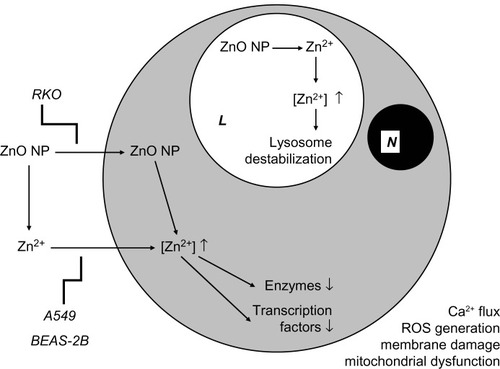Figures & data
Table 1 Overview of in vitro studies using zinc oxide nanoparticles
Figure 1 Putative mechanisms underlying the in vitro effects of ZnO NPs.
Notes: ZnO NPs dissolve in the extracellular milieu, resulting in an increased extracellular [Zn2+]. This in turn leads to an increased intracellular [Zn2+], resulting in reduced activity of Zn2+-dependent enzymes and Zn2+-dependent transcription factors. This mechanism has been suggested for A549 and BEAS-2B cells. Alternatively, ZnO NPs enter the cell, after which they dissolve intracellularly. This mechanism may apply to RKO cells. In lysosomes, ZnO NPs are dissolved, the low pH and lysosomal enzymes aiding in digestion of the protein corona. This leads to an increased intralysosomal [Zn2+], resulting in lysosomal destabilization. Toxic effects of ZnO NPs include intracellular Ca2+ flux, ROS generation, membrane damage, and mitochondrial dysfunction.
Abbreviations: L, lysosome; N, nucleus; NPs, nanoparticles; ROS, reactive oxygen species.
Abbreviations: L, lysosome; N, nucleus; NPs, nanoparticles; ROS, reactive oxygen species.
